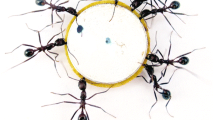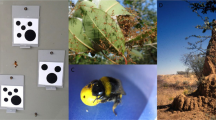Abstract
The behavioral mechanisms that lead to cooperation in social insects are often unknown or poorly understood. Cooperative transport, or the movement of an object by two or more individuals, is a particularly impressive example of collaboration among workers. Many ant species perform this behavior, but there is extreme interspecific variation in efficiency. Why are some ant species so efficient at cooperative transport, while others are so inefficient? Surprisingly, the scientific community has little proximate understanding of the adaptations that make certain species excel at this behavior. This work provides a review of the behavioral rules that separate the efficient cooperative transporters from the inefficient. We present two measures of efficiency of cooperative transport as well as a flowchart of the cooperative transport process. By identifying the steps and flow of information, the flowchart enables careful modeling of cooperative transport from a mechanistic perspective. Previous studies of each of the four phases of cooperative transport are discussed, including decision, recruitment, organization, and transport. We also present hypotheses regarding behavioral mechanisms that may modulate efficiency.


Similar content being viewed by others
References
Åkesson S. and Wehner R. 2002. Visual navigation in desert ants Cataglyphis fortis: are snapshots coupled to a celestial system of reference? J. Exp. Biol. 205: 1971–1978.
Amor F., Ortega P., Cerdá X. and Boulay R. 2009. Cooperative prey-retrieving in the ant Cataglyphis floricola: an unusual short-distance recruitment. Insect. Soc. 57: 91–94.
Berman S., Lindsey Q., Sakar M.S., Kumar V. and Pratt S.C. 2011. Experimental study and modeling of group retrieval in ants as an approach to collective transport in swarm robotic systems. Proc. IEEE 99: 1470–1481.
Breed M., Fewell J., Moore A. and Williams K. 1987. Graded recruitment in a ponerine ant. Behav. Ecol. Sociobiol. 20: 407–411.
Cerdá X., Angulo E., Boulay R. and Lenoir A. 2009. Individual and collective foraging decisions: a field study of worker recruitment in the gypsy ant Aphaenogaster senilis. Behav. Ecol. Sociobiol. 63: 551–562.
Cogni R. and Oliveira P. 2004. Recruitment behavior during foraging in the neotropical ant Gnamptogenys moelleri (Formicidae: Ponerinae): does the type of food matter? J. Insect Behav. 17: 443–458.
Couzin I.D., Krause J., James R., Ruxton G.D. and Franks N.R. 2002. Collective memory and spatial sorting in animal groups. J. Theor. Biol. 218: 1–11.
Czaczkes T.J. and Ratnieks F.L.W. 2011. Simple rules result in the adaptive turning of food items to reduce drag during cooperative food transport in the ant Pheidole oxyops. Insect. Soc. 58: 91–96.
Czaczkes T.J. and Ratnieks F.L.W. 2012. Pheromone trails in the Brazilian ant Pheidole oxyops: extreme properties and dual recruitment action. Behav. Ecol. Sociobiol. 66: 1149–1156.
Czaczkes T.J. and Ratnieks F.L.W. 2013. Cooperative transport in ants (Hymenoptera: Formicidae) and elsewhere. Myrmecol. News 18: 1–11.
Czaczkes T.J., Nouvellet P. and Ratnieks F.L.W. 2011. Cooperative food transport in the Neotropical ant, Pheidole oxyops. Insect. Soc. 58: 153–161.
Czaczkes T.J., Vollet-Neto A. and Ratnieks F.L.W. 2013. Prey escorting behavior and possible convergent evolution of foraging recruitment mechanism in an invasive ant. Behav. Ecol. 24: 1177–1184.
Daly-Schveitzer S., Beugnon G. and Lachaud J.-P. 2007. Prey weight and overwhelming difficulty impact the choice of retrieval strategy in the Neotropical ant Gnamptogenys sulcata (F. Smith). Insect. Soc. 54: 319–328.
Detrain C. and Deneubourg J.-L. 1997. Scavenging by Pheidole pallidula: a key for understanding decision-making systems in ants. Anim. Behav. 53: 537–547.
Franks N. 1986. Teams in social insects: group retrieval of prey by army ants (Eciton burchellii, Hymenoptera: Formicidae). Behav. Ecol. Sociobiol. 18: 425–429.
Franks N., Sendova-Franks A., Simmons J. and Mogie M. 1999. Convergent evolution, superefficient teams and tempo in Old and New World army ants. Proc. R. Soc. Lond. B 266: 1697–1701.
Franks N., Sendova-Franks A. and Anderson C. 2001. Division of labour within teams of New World and Old World army ants. Anim. Behav. 62: 635–642.
Hölldobler B. and Wilson E.O. 1990. The Ants. Belknap Press, Cambridge Massachusetts. 732 pp.
Hölldobler B., Stanton R.C. and Markl H. 1978. Recruitment and food-retrieving behavior in Novomessor (Formicidae, Hymenoptera). Behav. Ecol. Sociobiol. 4: 163–181.
Miyata H., Hirata M., Azuma N., Murakami T. and Higashi S. 2009. Army ant behaviour in the poneromorph hunting ant Onychomyrmex hedleyi Emery (Hymenoptera: Formicidae; Amblyoponinae). Aust. J. Entomol. 48: 47–52.
Moffett M. 1988. Cooperative food transport by an asiatic ant. Natl. Geogr. Res. 4: 386–394.
Moffett M. 1992. Ant foraging. Res. Explor. 8: 220–231.
Moffett M.W. 1986. Behavior of the group-predatory ant Proatta butteli (Hymenoptera: Formicidae): an old world relative of the attine ants. Insect. Soc. 33: 444–457.
Moffett M.W. 2010. Adventures among Ants: A Global Safari with a Cast of Trillions. University of California Press. 288 pp.
Pielstroem S. and Roces F. 2012. Vibrational communication in the spatial organization of collective digging in the leaf-cutting ant Atta vollenweideri. Anim. Behav. 84: 743–752.
Pratt S.C. 2005. Quorum sensing by encounter rates in the ant Temnothorax albipennis. Behav. Ecol. 16: 488–496.
Pratt S.C., Mallon E.B. Sumpter, D.J.T. and Franks N.R. 2002. Quorum sensing, recruitment, and collective decision-making during colony emigration by the ant Leptothorax albipennis. Behav. Ecol. Sociobiol. 52: 117–127.
Razin N., Eckmann J.P. and Feinerman O. 2013. Desert ants achieve reliable recruitment across noisy interactions. J. R. Soc. Interface. 10: 20130079.
Robson S. and Traniello J. 1998. Resource assessment, recruitment behavior, and organization of cooperative prey retrieval in the ant Formica schaufussi (Hymenoptera: Formicidae). J. Insect Behav. 11: 1–22.
Robson S. and Traniello J. 2002. Transient division of labor and behavioral specialization in the ant Formica schaufussi. Naturwissenschaften 89: 128–131.
Seeley T.D. and Visscher P.K. 2003. Choosing a home: how the scouts in a honey bee swarm perceive the completion of their group decision making. Behav. Ecol. Sociobiol. 54: 511–520.
Seeley T.D. and Visscher P.K. 2004. Quorum sensing during nest-site selection by honeybee swarms. Behav. Ecol. Sociobiol. 56: 594–601.
Steck K. 2012. Just follow your nose: homing by olfactory cues in ants. Curr. Opin. Neurobiol. 22: 231–235.
Sudd J.H. 1960. The transport of prey by an ant, Pheidole crassinoda EM. Behaviour 16: 295–308.
Sumpter D.J.T. 2010. Collective Animal Behavior. Princeton University Press. 302 pp.
Trager J.C., MacGown J.A. and Trager M.D. 2007. Revision of the Nearctic endemic Formica pallidefulva group. Mem. Am. Entomol. Inst. 80: 610–636.
Traniello J. and Beshers S. 1991. Maximization of foraging efficiency and resource defense by group retrieval in the ant Formica schaufussi. Behav. Ecol. Sociobiol. 29: 283–289.
Wittlinger M., Wehner R. and Wolf H. 2006. The ant odometer: stepping on stilts and stumps. Science 312: 1965–1967.
Wojtusiak J., Godzinska E. and Dejean A. 1995. Capture and retrieval of very large prey by workers of the African weaver ant, Oecophylla longinoda (Latreille 1802). Trop. Zool. 8: 309–318.
Yamamoto A., Ishihara S. and Ito F. 2008. Fragmentation or transportation: mode of large-prey retrieval in arboreal and ground nesting ants. J. Insect Behav. 22: 1–11.
Acknowledgments
We thank the Plant–Animal Interactions Discussion Group, the Breed Lab, and Tim Szewczyk for their helpful comments on the manuscript. We thank the Breed Lab and the Taco Tuesday Group for feedback on ideas and implications. H.M. was supported by the University of Colorado, Boulder, Department of Ecology and Evolutionary Biology.
Author information
Authors and Affiliations
Corresponding author
Rights and permissions
About this article
Cite this article
McCreery, H.F., Breed, M.D. Cooperative transport in ants: a review of proximate mechanisms. Insect. Soc. 61, 99–110 (2014). https://doi.org/10.1007/s00040-013-0333-3
Received:
Revised:
Accepted:
Published:
Issue Date:
DOI: https://doi.org/10.1007/s00040-013-0333-3




